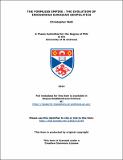Files in this item
The formless empire : the evolution of indigenous Eurasian geopolitics
Item metadata
| dc.contributor.advisor | Williams, Andrew J. | |
| dc.contributor.author | Mott, Christopher Douglas | |
| dc.coverage.spatial | 221 | en_US |
| dc.date.accessioned | 2014-08-14T10:12:19Z | |
| dc.date.available | 2014-08-14T10:12:19Z | |
| dc.date.issued | 2014-06-24 | |
| dc.identifier.uri | https://hdl.handle.net/10023/5149 | |
| dc.description.abstract | This dissertation seeks to make a unique contribution to the study of geopolitics and empire in Central Asia by focusing on both the indigenous developments of grand strategies and their legacies by examining several key points in the history of the region’s geopolitics in order to determine the peculiar and specific nature of regional geopolitical evolution, and how its basic concepts can be understood using such a locally based framework. By putting the focus on several key concepts which hold steady through major societal and technological upheavals, as well as foreign incursion and both the inward and outward migrations, which together create the conditions which I have dubbed ‘The Formless Empire’, it is possible to see the elements of a regional and homegrown tradition of grand strategy and geopolitical thinking which is endemic to the area of Inner Eurasia, even as this concept adapts from a totality of political policy to merely frontier and military policy over the course of time. This indigenous concept of grand strategy encompasses political, military, and diplomatic aspects utilizing the key concepts of strategic mobility, and flexible or indirect governance. These political power systems originated in their largest incarnations amongst the nomadic people of the steppe and other people commonly considered peripheral in history, but who in a Central Asian context were the original centerpieces of regional politics until technological changes led to their eclipse by the big sedentary powers such as Russia and China. However, even these well-established states took elements of ‘The Formless Empire’ into their policies (if largely relegated to frontiers, the military, and a few informal relationships alone) and therefore the influence of the region’s past still lingers on in different forms in the present. | en_US |
| dc.language.iso | en | en_US |
| dc.publisher | University of St Andrews | |
| dc.rights | Creative Commons Attribution 4.0 International | |
| dc.rights.uri | http://creativecommons.org/licenses/by/4.0/ | |
| dc.subject | Geopolitics | en_US |
| dc.subject | Central Asia | en_US |
| dc.subject | Eurasia | en_US |
| dc.subject | History | en_US |
| dc.subject.lcc | JC319.M77 | |
| dc.subject.lcsh | Geopolitics--Asia, Central | en_US |
| dc.subject.lcsh | Asia, Central--History | en_US |
| dc.title | The formless empire : the evolution of indigenous Eurasian geopolitics | en_US |
| dc.type | Thesis | en_US |
| dc.type.qualificationlevel | Doctoral | en_US |
| dc.type.qualificationname | PhD Doctor of Philosophy | en_US |
| dc.publisher.institution | The University of St Andrews | en_US |
This item appears in the following Collection(s)
Except where otherwise noted within the work, this item's licence for re-use is described as Creative Commons Attribution 4.0 International
Items in the St Andrews Research Repository are protected by copyright, with all rights reserved, unless otherwise indicated.


